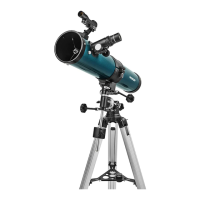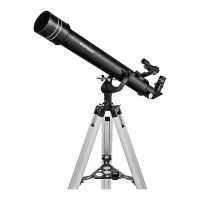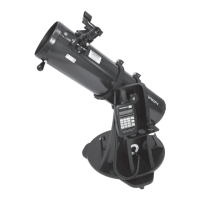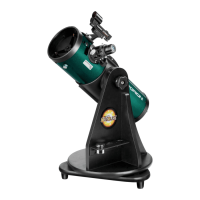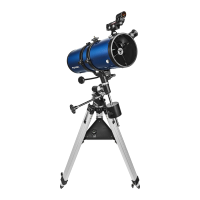7
Balancing the Telescope
In order for the telescope to move smoothly on its mechanical
axes, the optical tube must rst be balanced on the mount as
follows:
1. Keeping one hand on the telescope optical tube, loosen
the R.A. lock knob. Make sure the Dec. lock knob is locked,
for now. The telescope should now be able to rotate freely
about the R.A. axis. Rotate it until the counterweight shaft
is parallel to the ground, i.e., horizontal (Figure 20a).
2. Now loosen the counterweight lock knob and slide the
weight along the shaft until it exactly counterbalances the
telescope. That’s the point at which the shaft remains hori-
zontal even when you let go of the telescope with both
hands.
3. Retighten the counterweight lock knob. The telescope is
now balanced on the R.A. axis.
4. To balance the telescope on the Dec. axis, rst tighten
the R.A. lock knob, with the counterweight shaft still in the
horizontal position.
5. With one hand on the telescope optical tube, loosen the
Dec. lock knob. The telescope should now be able to rotate
freely about the Dec. axis (Figure 20b). Loosen the tube
Figure 16.
Insert the red dot nder scope’s bracket foot
into the base near the focuser as shown.
Figure 14. Installing the tube ring onto the equatorial mount. a) Place open ring in saddle. b) Insert socket head screws through aligned
holes in ring and saddle, then c) place a washer onto the screw followed by a wing nut. Then tighten wing nut.
Finderscope base
Foot
Figure 15. Lay the optical tube in the open tube ring, then
close the ring and clamp it with the tube ring clamp knob.
Socket head
bolts
Tube ring (open)
Ring clamp
knob
Latitude
scale
Latitude
adjustment
bolt
Saddle
Washer
Wing nut
b.
a.
c.

